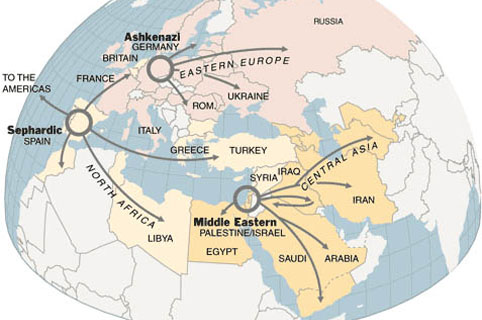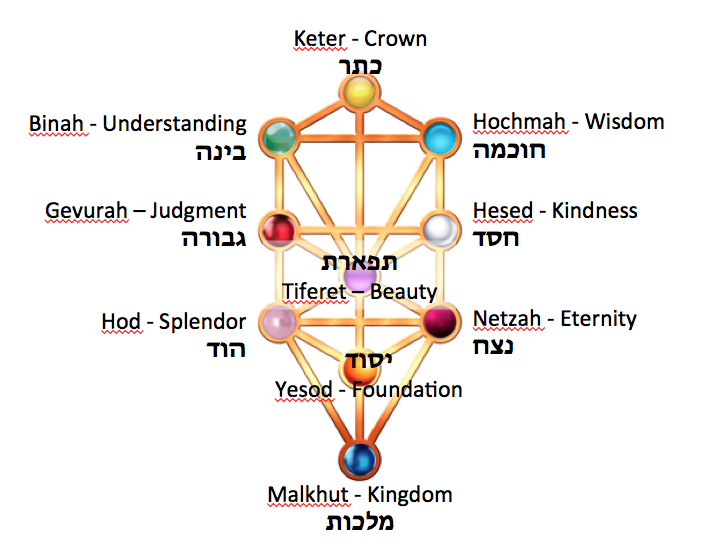いわゆるユダヤ人の神秘思想カバラについて
スポンサードリンク

カバラとは何か?
カバラとは何かについて初心者に向けて書かれた英文記事があったので紹介します。
https://www.chabad.org/library/article_cdo/aid/170308/jewish/What-is-Kabbalah.htm
カバラの原意は「受け取られたもの」
It is important to realize that the Kabbalah is more about losing ourselves than about finding, becoming more other-centered and less ego-centered.
The literal translation of the word Kabbalah is 'that which is received.' To receive we must be receptive. We must open ourselves, creating a vessel in which to absorb that which we wish to understand or grasp, and in turn become part of Kabbalah.
To open the self to a higher reality, to view the spirit within the matter, to raise our consciousness to the point where our perception of reality is completely changed, and the divine within all creation is revealed.
カバラとは「見つけるより多くを失うこと」であり、「自分中心を離れて他者中心になること」である。まずそれを認識することが大事だ。
カバラという言葉は「受け取られたもの」を意味する。人が何かを 受け入れるには受け入れる器が要る。何か理解したい、把握したいものがあるのであれば、己を開放し、受け入れ準備をしてカバラに入っていく必要がある。
高次の現実に自分を解き放ち、モノの中に霊を見、現実の認識が完全に変わるところまで意識を引き上げた時点で、すべての創造物に宿っている神性が明かされてくる。
カバラの発展についての寓話
A famed Kabalistic Master, the Tzadik of Zitshav, once observed regarding the Kabbalah that these three stages in its development can be related to a parable.
かつて高名なカバラの師ツァディクは次の寓話を示した。カバラの発展は3つの段階を経るというのである。
第一の旅人
In a time when travel was a perilous and arduous venture and most people had never been outside their little village, a man journeyed to a distant land. Upon his return, he gathered together the people of his village and enthusiastically related the great adventures of his voyage. He spoke of a bird he had seen in a distant land, whose features were remarkable. For example, the bird's face was human; his legs were that of a giraffe. The villagers scoffed and dismissed his story as utter fantasy.
旅が危険で命がけの大仕事だった時代、ほとんどの村人は自分たちの狭い村から一歩も外へ出たことがなかった。ある男が多く土地に旅に出かけた。彼は村へ戻ってくると村人を集め、熱心に冒険譚を語った。その中で遠くの土地で見た珍しい鳥の話をした。鳥は人間の顔し、キリンの脚を持っているという。
第二の旅人
Inspired by the adventurers of his tales, a fellow villager set out on the same voyage determined to see the world for himself. Years later he returned to his village, a man of the world. Like the traveler who had so inspired him, he gathered the village folk and related his adventures. He too spoke of this fantastic bird, but the description was slightly different. The face of the bird, he said, was not actually human, although it closely resembled one, and the legs were long and spindly and definitely brought to mind the giraffe; however, they were most certainly not actual giraffe's legs. Upon hearing this man's story, the villagers were divided. Some wholeheartedly believed this man whose story was more convincing than the first traveler. Yet there were plenty of skeptics, to whom the story still sounded entirely contrived and unrealistic.
村人はバカにしておとぎ話で済ませたが、一人の男はその話に魅せられ、自分自身の目で確かめようと旅に出る決心をした。彼は世界を知る男になって帰還すると、やはり村人を集め、冒険話を開陳した。話が例の鳥に及ぶと彼はちょっと違う説明をした。鳥の顔は人間にとてもよく似ているが、人間の顔ではない。脚は確かにキリンのように長くてふらふら歩いていたが、キリンの脚ではない。この話を聞いた村人の意見は割れた。最初の男の話よりずっと納得できるといって完全に男を信じる者もあったが、大方の村人は懐疑派だった。彼らの耳にはこの男の話も非現実的な空想に聞こえたからだ。
第三の旅人
One of the villagers was determined to bring a final conclusion to the matter of this strange bird and undertook the arduous journey himself. Upon his return he gathered together the villagers and triumphantly proclaimed, the matter is settled! Whereupon he reached into his large bag and withdrew this strange and fantastic bird. This time there was not a skeptic to be found.
別の村人がこの鳥の問題に決着をつけるといって危険な旅に出かけた。村に戻ってくると彼は勝ち誇ったように「ケリはついた!」と宣言した。大きな鞄に手を伸ばすと、そこからこの世のものとは思えない奇妙な鳥を取り出した。これで懐疑派はすっかり居なくなった。
第一段階:古典『ゾハールの書』の誕生
This parable relates to the three stages in the development of the theoretical domain of Kabbalah.
The author of the Zohar, the main body of Kabalistic thought, Rabbi Shimon Bar Yochai, was the first to describe the Divine presence and our relationship with the Ein Sof. In the Zohar, we find such strange and fantastic tales, such mythical and mystical configurations and images, that we can hardly believe.
ツァディク師は、旅に出かけた村人のそれぞれがカバラ理論の発展段階に相当するという。カバラ思想の基本文献とされる古典『ゾハールの書』を著したシモン・バル=ヨハイ師は、まず、神の存在、そして人間とエイン・ソフの関係について説いた。『ゾハールの書』には奇妙で空想的な話、神秘的配置図(※セフィロトの樹のこと)、イメージなどが含まれているが、どれも俄かには信じがたいものばかりだ。
https://kotobank.jp/word/%E3%82%BE%E3%83%8F%E3%83%BC%E3%83%AB-90278
第二段階:総合編集と体系化
In the 16th century, in Safed, the city of mystics, the Kabbalah began to take on a more comprehensive, detailed form and analysis. Patterns and systematic thought processes began to appear in Kabalistic literature.
16世紀、神秘家の街ツファット(イスラエル北部ガリラヤ地方の都市)で、カバラは詳しく分析され、総合的な形式に編集された。この頃から、カバラの著作にパターンや体系的な思考過程が見られるようになった。
第三段階:ハシディズムの登場
Ultimately, with the birth of the Chassidic movement, Kabbalah has come to its full fruition. Chassidism is the mystical movement founded by R. Yisrael Ben Eliezer, the Ba'al Shem Tov. He brought the image of the Creator into reality. No longer were these mystical concepts farfetched and unrealistic, rather they became a concrete part of our everyday lives, affecting every facet of creation. Heaven was brought down to Earth.
そして(※18世紀の)ハシディズム運動(※通常、英語でのつづりはHasidism)の誕生をもってカバラは完成された。ハシディズムはラビのイスラエル・ベン・エリエゼル(バアル・シェム・トーヴ)が創始した神秘主義運動で、彼の手で創造者のイメージが現実に降ろされた。カバラは現実にはありえない神秘的な観念であることをやめ、日常生活の一部を構成し、創造のあらゆる側面に関係する具体的なものとなった。天国が地上に実現されたのである。
カバラの円環
The purpose of the Kabbalah is fraught with misconceptions. A popular misunderstanding is that the study of Kabbalah is meant to transform one into a psychic, or perhaps a clairvoyant, capable of miraculous and otherworldly abilities. This, however, is a misconception. The ultimate purpose in the study of Kabbalah is the perfection of the Self. Making the Self into a better, more expanded individual, more transcendent, more attuned to the essence and roots of one's soul, this is what Kabbalah comes to offer those who truly wish to receive it.
カバラの目的はひどく誤解されている。典型的な誤解は、カバラを学んだ人が霊能者や透視能力者になって、現実とかけ離れた奇蹟を起こす力を得るというものだが、それは間違いである。カバラを学ぶ究極的な目的は、自我を完全なものにすることにある。自我をより良い、拡張された個人に変えること、もっと超越的な自我に至ること、もっと魂の根源に同調させること。本当に「それを受け取る」ことを望む人はこうした贈り物を受け取るのである。
一周して元に戻る:いまここの精神
The criterion of the authentic and Kabbalistic journey is one that comes full circle and where one returns ultimately to the world of the here-and-now.
The Talmud tells of four sages who entered the mystical orchard and experienced a transcendental experience. Ben Azzai gazed and died. Ben Zoma gazed and was stricken. In other words, he went insane. Acher (the other) (nee Elisha Ben Avuyah) gazed and cut off his plantings, that is, transmogrified into a heretic. Rabbi Akiva entered and exited in peace. The orchard represents the higher spiritual realms. Rabbi Akiva was the only sage, amongst these four great sages, who was able to enter and exit the mystical orchard without being scarred. Being a man of great spiritual stature, a true and well balanced master, he realized that the objective is not to identify with the light and not return, physically, as Ben Azzai did, or mentally as Ben Zoma did. Nor, was it to feel personal release or ecstasy, but rather to go there and return here, with the proper wisdom to serve in the here-and-now. The journey is to come full circle into one's day-to-day life behaviors.
正真正銘のカバラの旅程を判定する基準は、旅程が完結した時点で「いまここ」の世界に戻ってこれるかどうかにある。
タルムード(口伝律法書)には神秘の果樹園(※Pardes、パラダイス)に入って超越体験をした四人の聖人の話が収められている。
ベン・アッザイは凝視して亡くなった。ベン・ゾーマは凝視して病んだ(気が狂った)。エリシャ・ベン・アブヤは凝視して自分の絵を切り裂いた(異端に堕ちた)。ラビ・アキヴァは無事に果樹園を出た。
果樹園は高次の霊的領域を指すが、四人のうち無傷で果樹園から生還できたのはアキヴァ師だけである。バランスの取れた真正の霊的ラビだった彼は、カバラの目的が、光と合一した後、二度とこの世に戻らないことではない、と知っていた(アッザイは肉体的に、ゾーマは精神的に戻らなかった)。また、その目的は個人的な解放感や恍惚感を得ることでもない。
カバラの目的は行って戻ってくること、すなわち正しい知恵で「いまここ」に仕えることにある。日常的ふるまいの世界へ戻って初めてカバラの旅程は完全な円を描き完結するのである。
カバラの目的
エイン・ソフ(無限)の自覚
The primary objective of mystical thought is to make the person understand that there is nothing else besides the Infinite. Reading the various configurations, maps, and diagrams the Kabbalah presents, the person is supposed to be awakened to consciousness that all that really exists is the Ein Sof. There is a feeling tone that is to be aroused when we penetrate the truths of Kabbalah, and that is the feeling that the world as we tend to perceive it, as separate, independent of a creator, is but an illusion, and in reality there is nothing other than the infinite light. Having this notion in mind, consciously or even subconsciously, we are then able to conquer all our personal negative emotions and traits.
神秘思想の主目的は、無限以外、何もないことを人に理解させることにある。カバラが示す様々な配置図(※セフィロト)、地図、図像などは、エイン・ソフ(Ein Sof)が真の実在であることを意識に自覚させるための方便である。
カバラの真理に達すると、こみあげてくる感覚がある。この感覚を得ると、この世界が創造主とは別個の、独立した存在だという思い込みが錯覚に過ぎないことがはっきりわかってくる。実際、存在するのは無限の光だけだ。この認識を心に持った者は、意識的に(あるいは無理に意識しなくても)人間のあらゆるネガティブな特性、否定的な感情を克服できる。
自我に起因する否定感情の克服
R. Eliyahu ben Moshe Di Vidas, a 16th century Kabbalist, deposits that there are three primary negative traits, which may be considered the 'principal traits' from which all further dissention occurs. They are: haughtiness, stubbornness, and anger, all of which claim origin in the same source, that is, the ego. Ego is the fountainhead from which all negativity stems. The core of all corruption is that false sense of self/ego, which lives in an incessant state of what it thinks will cause its survival.
16世紀のカバラ主義者ベン・モシェ・ディ・ヴィダスによれば、ネガティブな特性とは主に傲慢、頑迷、怒りの3つだ。この3つは様々な不和の原因となるが、すべて同じエゴ(自我)に端を発している。ネガティブな特性の大元は自我である。腐敗の核心は自己と自我に関する誤認だ。人はネガティブな特性によって命をつないでいるという錯覚である。
It is the ego which give rise to all negative emotions. For example, when a person becomes angry, it is the ego's way of showing its objection that it is not happy. The ego, when it feels it is threatened, is the one who protests: 'how can you do this to me,' which arouses the anger.
The fear of annihilation is the constant condition with regards to the ego. Anger is but a manifestation of a persons preoccupation with his imaginary presumptions of survival. The total involvement with the illusory 'self' is the root of all negative emotions.(中略)
否定的な感情の生みの親は自我だ。たとえば、怒りとは、ハッピーじゃないという自我の意思表示である。自我は攻撃を受ければ防衛に動く。そして「どうしてそんなことする?」と抗議する。
また自我はつねに消滅を恐れている。怒りは、想像上の生存の脅威に対する怒れる者の先入観の表明にほかならない。「自己」幻想への没入はあらゆる否定的感情の根源となる。(中略)
光(オール・エイン・ソフ)を得て自我を乗り超える
In the place of seeing the ego as a real enemy who needs to be engaged in battle in order to be overcome, we begin to realize that there is nothing besides the Light, and everything else is simply a concealment of that truth.
Such is the Kabbalistic approach for self-perfection. It does not deal with the negative head-on, nor does it deal with it at all. Rather it goes to the source of all problems, the I/ego, and by extension, the entire physical reality, and it demonstrates how, in fact, these seemingly independent realities are but a camouflage. By realizing this, our negativity is more easily overcome.
(カバラを体得すると)自我を本物の敵と見なして、自我を戦いに巻き込んで負かそうなどとは思わなくなる。この世界には光以外何もないという認識がやってくる。他のことはこの真理を覆い隠す作用でしかない。
カバラの自己完成とはこの真理の覚知を指す。カバラは否定的な衝突に関与しない。その代り、あらゆる問題の根源である「私」と「自我」に向き合う。
さらに広義には、物理的な現実界の総体を問う。物理的現実は独立した一個の現実に映るが、それが見せかけ以外の何者でもないことを示す。現実のまやかしを認識すれば、否定感情を容易に乗り超えられるようになる。
<記事引用終わり>
万有の根源アインとエイン・ソフ、イェシ
ここからは英語版Wikiの引用です。
https://en.wikipedia.org/wiki/Ayin_and_Yesh
Ayin ("nothingness", related to Ein-"not") is an important concept in Kabbalah and Hasidic philosophy. It is contrasted with the term Yesh ("something/exist/being/is"). According to kabbalistic teachings, before the universe was created there was only Ayin, and the first manifest Sephirah (Divine emanation), Chochmah (Wisdom), "comes into being out of Ayin."
In this context, the sephirah Keter, the Divine will, is the intermediary between the Divine Infinity (Ein Sof) and Chochmah. Because Keter is a supreme revelation of the Ohr Ein Sof (Infinite Light), transcending the manifest sephirot, it is sometimes excluded from them.
アイン(何もないこと)はカバラ哲学(および18世紀南ポーランドに生まれたハシディズム運動)の重要概念。イェシ(何かあること)と対照を成す。カバラ哲学では、宇宙が創造される前にはただアインのみが在った、と考える。創造とはアインからのセフィラー(神の流出)であり、最初に示現されたセフィラ―をコクマー(知恵)と呼ぶ。コクマーはアインから流出して生じたのである。
この状況において、ケテル(神の意思を意味するセフィラ―)は、エイン・ソフ(神の無限性)とコクマーの仲立ちである。ケテルはオール・エイン・ソフ(無限の光)の至高なる啓示であるから、示現されたすべてのセフィロト(セフィラ―の複数形)を超越している。したがってケテルはセフィロトの象徴図から除外されることがある。
 セフィロトの木(Sephirothic tree)、 生命の木(Tree of Life)とも呼ばれる。創世記(2:9以降)に出てくるエデンの園の中央に植えられた木のこと(出典:http://www.walkingkabbalah.com/kabbalah-tree-of-life-sephirot/)。
セフィロトの木(Sephirothic tree)、 生命の木(Tree of Life)とも呼ばれる。創世記(2:9以降)に出てくるエデンの園の中央に植えられた木のこと(出典:http://www.walkingkabbalah.com/kabbalah-tree-of-life-sephirot/)。
アインとエイン・ソフ、イェシ
Ayin is closely associated with the Ein Sof ("no end", "without an end"), which is understood as the Deity prior to His self-manifestation in the creation of the spiritual and physical realms, single Infinite unity beyond any description or limitation.
From the perspective of the emanated created realms, Creation takes place "Yesh me-Ayin" ("Something from Nothing"). From the Divine perspective, Creation takes place "Ayin me-Yesh" ("Nothing from Something"), as only God has absolute existence; Creation is dependent on the continuous flow of Divine lifeforce, without which it would revert to nothingness.
アインとエイン・ソフ(終わりなさ)の間には密接な関係がある。霊の領域と物の領域の創造は神が神自身を示現した結果生まれたが、その創造に先立つ神は、あらゆる描写や制約を超えた、無限の一なる状態にあった。この状態をエイン・ソフという。
神の流出の結果創造された領域から見れば、それは「無から有」であるが、神の視点から見れば創造は「有から無」として起きたのである。絶対存在としてすべてに超越するのは神だけだからだ。神の生命力の絶えざる流出がなければ創造は成り立たない。流出が止まれば創造物は無に帰する。
<記事引用終わり>